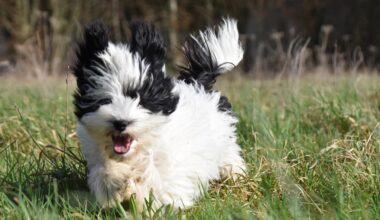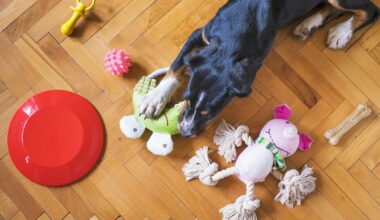Hydration Strategies for Dogs with Parvovirus
Parvovirus is a serious, highly contagious viral infection that predominantly affects puppies. One of the primary concerns when managing parvovirus is maintaining proper hydration. Dogs with parvovirus often suffer from severe vomiting and diarrhea, leading to dehydration. It is crucial to understand the signs of dehydration, which can include dry gums, lethargy, and loss of skin elasticity. Monitoring your dog closely can help you recognize any early signs of dehydration. If you suspect your dog may be dehydrated, it is essential to consult a veterinarian immediately. Initial treatment often requires intravenous fluids to restore hydration levels. Furthermore, offering oral rehydration solutions specifically designed for dogs can be beneficial. These solutions help replenish lost electrolytes and fluids. Always ensure that fresh water is available, as this encourages your dog to drink. In severe cases, it may be necessary to provide hydration support through a syringe if your dog refuses to drink. Remember that prompt action is critical in managing parvovirus, and hydration plays a vital role in your dog’s recovery.
Furthermore, feeding your dog bland foods can help maintain hydration and promote recovery. Foods such as boiled chicken and rice are gentle on the stomach and can aid in restoring your dog’s health during this challenging time. It’s essential to introduce these foods gradually, ensuring that your dog can tolerate them without subsequent vomiting. If your dog is unwilling to eat, experimenting with different textures and types of food can stimulate their appetite. Consider adding some low-sodium broth to the chicken and rice, which not only enhances flavor but also provides additional hydration. Many dog owners favor using commercially available recovery diets that are formulated to provide essential nutrients while being easy on the digestive system. Always check with your veterinarian before making significant changes to your dog’s diet during their illness. Additionally, ensuring a worry-free environment during recovery helps your dog feel secure and relaxed, encouraging food and water intake. It is important to remain attentive to your dog’s needs and to adjust care protocols based on their response to treatment.
Recognizing Dehydration Symptoms
To effectively manage hydration in dogs suffering from parvovirus, recognizing dehydration symptoms is essential. As mentioned, common symptoms include dry mouth, sunken eyes, and lethargy. Feel your dog’s skin; if it doesn’t quickly return to place, this indicates dehydration. A good practice is to perform the skin tent test, where you lift the skin on the back of the neck and observe how fast it returns. Assessing your dog’s coat condition is also crucial; a dull coat can be an outside indicator of internal health issues. Another important step is to ensure your veterinarian constantly stays updated regarding your dog’s condition. Regular check-ups can help gauge hydration and other vital signs. In cases where dehydration is significant, the veterinarian may recommend hospitalization for more timely and extensive treatment. Other tracking methods include keeping a journal of your dog’s food and water intake. Monitoring their urination can also be insightful; dark or infrequent urine may indicate dehydration. Make it a priority to stay observant about your dog’s well-being to ensure proper intervention at the right time. Early detection leads to better outcomes.
Hydration Methods to Consider
There are multiple methods you can use to keep your dog hydrated during a parvovirus infection. Oral rehydration solutions, which contain electrolytes, are available at many pet stores and can provide vital support. You can also prepare homemade solutions by mixing electrolytes with plain water, but always consult your veterinarian for the best ratio. Using a bulb syringe or a syringe can help deliver fluids directly into your dog’s mouth if they refuse to drink. This method is especially useful for severely dehydrated dogs. Another technique involves using ice cubes; some dogs prefer licking ice to drinking water. Offer them small pieces and monitor their response. Using a pet water fountain can also encourage your dog to drink more than they typically would. The sound of flowing water often intrigues pets, boosting their water intake. Keep fresh bowls of water in different areas of your home, ensuring accessibility at all times. Having ice chips or moistening foods can make a significant difference in hydration levels as well. A well-rounded strategy should consist of various methods to ensure adequate hydration.
Moreover, you should maintain a consistent monitoring schedule for both food and water intake. This strategy will pinpoint what your dog prefers and how much they are consuming. If hydration efforts do not yield noticeable improvement, discuss fluid therapy options with your veterinarian. Providing a comfortable and quiet space can help reduce your dog’s stress, promoting better hydration. Additionally, ensure that your dog receives regular, gentle exercise to stimulate appetite and circulation. Exercise should be balanced and appropriate for their energy level while they recover. In severe cases of dehydration or if vomiting persists, seek immediate veterinary intervention. Hospitalization may be necessary for intravenous fluid therapy, which rapidly replenishes your dog’s hydration levels. Alongside hydration, pay attention to your dog’s overall comfort; a calm environment aids healing. Lastly, remember that repeated checking for signs of recovery is paramount. Continuous observation acts as an early warning system for owners, allowing for proactive steps in care. Your commitment to monitoring and supporting your dog is integral during this time.
Long-term Health Considerations
After recovering from parvovirus, long-term health considerations become significant. Continued focus on hydration remains essential even after the initial illness phase. Ensure that your dog maintains a healthy weight in the weeks following recovery, as parvovirus can cause lasting weight loss and muscle mass loss. Gradually reintroducing a balanced diet rich in nutrients can help restore energy and condition. Regular vet check-ups will allow you to monitor your dog’s health and nutritional status. Vaccination is crucial to prevent future infections; be diligent about keeping vaccinations up to date. Educating yourself about other common dog illnesses can also prepare you better as a pet owner. Engage in regular wellness checks and grooming routines to enhance your dog’s overall well-being. Provide plenty of love and encouragement as they transition into their recovery phase. Consider incorporating probiotics or digestive aids into their diet to support gut health due to the intestinal damage from parvovirus. Staying proactive about your dog’s health not only aids in their recovery but will help nurture a happy and healthy pet long-term.
Finally, maintaining open communication with your veterinarian is crucial in ensuring a smooth recovery. Stay alert for any sudden changes in your dog’s behavior or health status as they recuperate. This vigilant approach allows you to address potential issues before they escalate. Share your observations regarding hydration and eating habits, so your veterinarian can adjust recommendations based on their unique needs. Also, consider educational resources or support groups for pet owners dealing with parvovirus. Connecting with others who’ve faced similar challenges can provide valuable insights and moral support. Furthermore, sharing your experiences may help others navigate through their dogs’ illnesses. Your dedication as a pet owner plays a vital role in your dog’s recovery process. It’s important to be patient and give your pet the time they need to regain strength and stability. With proper care, attention, and the correct hydration strategies in place, your dog can overcome the difficulties posed by parvovirus. Ultimately, your efforts can play a significant role in ensuring life continues healthily and happily after this brave battle.


